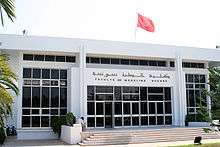Languages of Tunisia

Tunisia is, in terms of language, the most homogeneous of the Maghreb states.[1] This is because almost the entire population speaks Tunisian Arabic (also called Darija) natively. Most are also literate in Literary Arabic, which is the country's official language, and French.
Tunisian Arabic
The Tunisian Darija is considered a variety of Arabic – or more accurately a set of dialects[2] – for which there is no official body of standards. It is established on a Berber[3] and Punic[4] substratum, influenced by the languages of the people that lived in and/or administered the region during the course of history, including: Arabic, Turkish, Italian, Spanish and French. Tunisian is the language usually spoken by Tunisians in the context of daily dialogue within the family. According to linguistic studies, it is closely related to Maltese.[5]
Berber languages
Berber languages (called "chelha") are spoken by less than 1% of the population, mainly in the semi-Berber villages of the south, including Chenini, Douiret, Matmata and Tamezrett. They are also spoken in some villages on the island of Djerba, mainly Guellala, Iquallalen, Ajim, Sedouikech, Azdyuch and Ouirsighen.
French
During the French protectorate of Tunisia, French was imposed through public institutions, most notably the education system, which became a strong vehicle for dissemination of the language. From independence, the country gradually became arabized even though the public administration and education remained bilingual.[6] Meanwhile, knowledge of French and other European languages (such as English and Italian) is enhanced by Tunisia's proximity to Europe and by media and tourism.
The 1990s marked a turning point for the arabization process. Science classes up to the end of middle school were arabized in order to facilitate access to higher education and promote the Arabic language in society.[6] Since October 1999, private establishments have been obliged to give Arabic characters twice the size of Latin characters.[6] This rule is not always followed, however. At the same time, the public administration is required to communicate in Arabic only. In this context, the use of French seems to be in decline despite the increased number of graduates in the educational system, which leads to the fact that a good knowledge of French remains an important social marker.[6] This is because French is widely used in the business community, intellectual domains and the spheres of natural science and medicine. Because of this, one can even consider the language to have become gentrified.[6]
According to recent estimates provided by the Tunisian government to the Organisation Internationale de la Francophonie, the number of French speakers in the country is estimated at 6.36 million people, or 63.6% of the population.[7]
See also
- Demographics of Tunisia
- Arab world
- Arabized Berber
- French language in the Maghreb
- Languages of Algeria
- Languages of Morocco
References
- ↑ (French) Aménagement linguistique en Tunisie (Université de Laval)
- ↑ « Travaux de phonologie. Parlers de Djemmal, Gabès, Mahdia (Tunisie) et Tréviso (Italie) », Cahiers du CERES, Tunis, 1969
- ↑ name="Mohand">Tilmatine Mohand, « Substrat et convergences : Le berbère et l'arabe nord-africain », Estudios de dialectologia norteaafricana y andalusi, n°4, 1999, pp. 99-119
- ↑ Benramdane, Farid (1998). "Le maghribi, langue trois fois millénaire de ELIMAM, Abdou (Éd. ANEP, Alger 1997)". Insaniyat (in French) (6): 129–130. Retrieved 12 February 2015.
- ↑ Albert J. Borg et Marie Azzopardi-Alexander, Maltese, éd. Routledge, New York, 1996, p. XIII ISBN 0415022436
- 1 2 3 4 5 Samy Ghorbal, « Le français a-t-il encore un avenir ? », Jeune Afrique, 27 avril 2008, pp. 77-78
- ↑ (French) "Christian Valantin (sous la dir. de), La Francophonie dans le monde. 2006-2007, éd. Nathan, Paris, 2007, p. 16" (PDF). (5.58 MB)
Further reading
- Gabsi, Zouhir. "Attrition and maintenance of the Berber language in Tunisia." International Journal of the Sociology of Language, September 2011. Issue 211, p. 135. ISSN 0165-2516. Available on Academic OneFile.
- Stevens, P. (1983). "Ambivalence, Modernisation and Language Attitudes: French and Arabic in Tunisia." Journal of Multilingual and Multicultural Development. Volume 4, Nos. 2 and 3, p. 101-14.